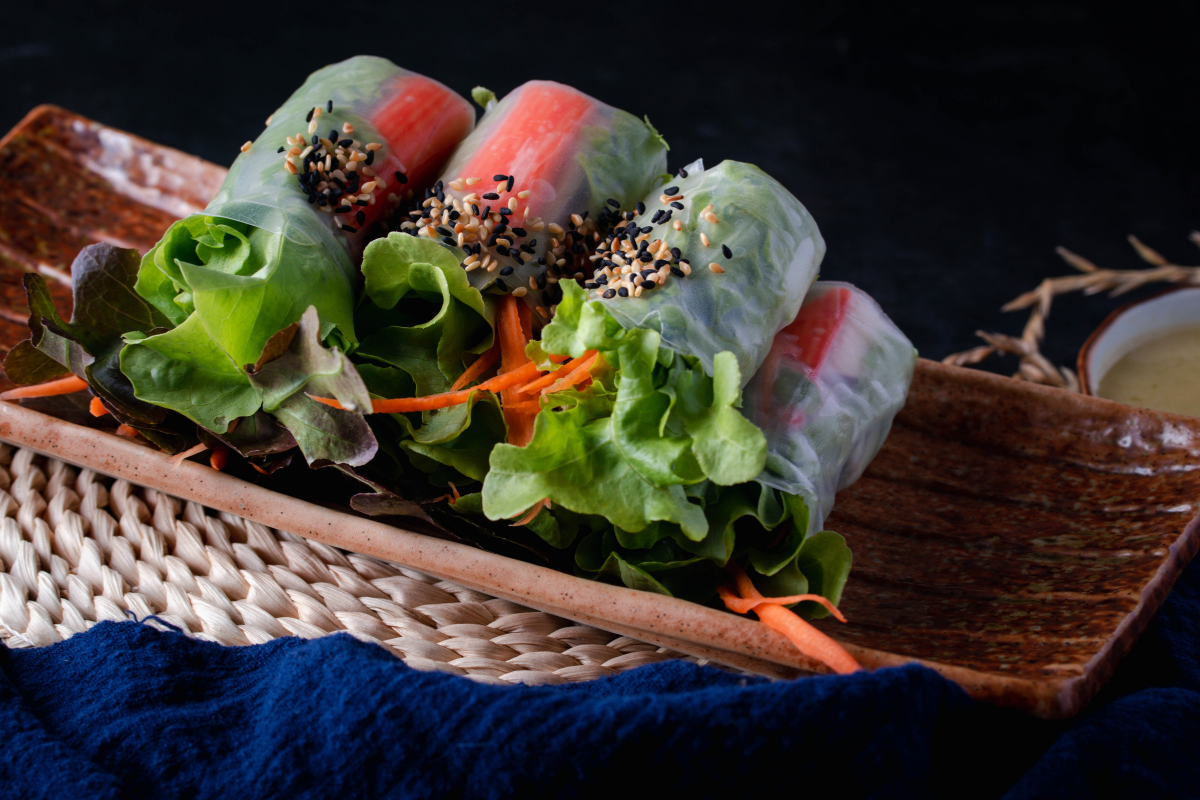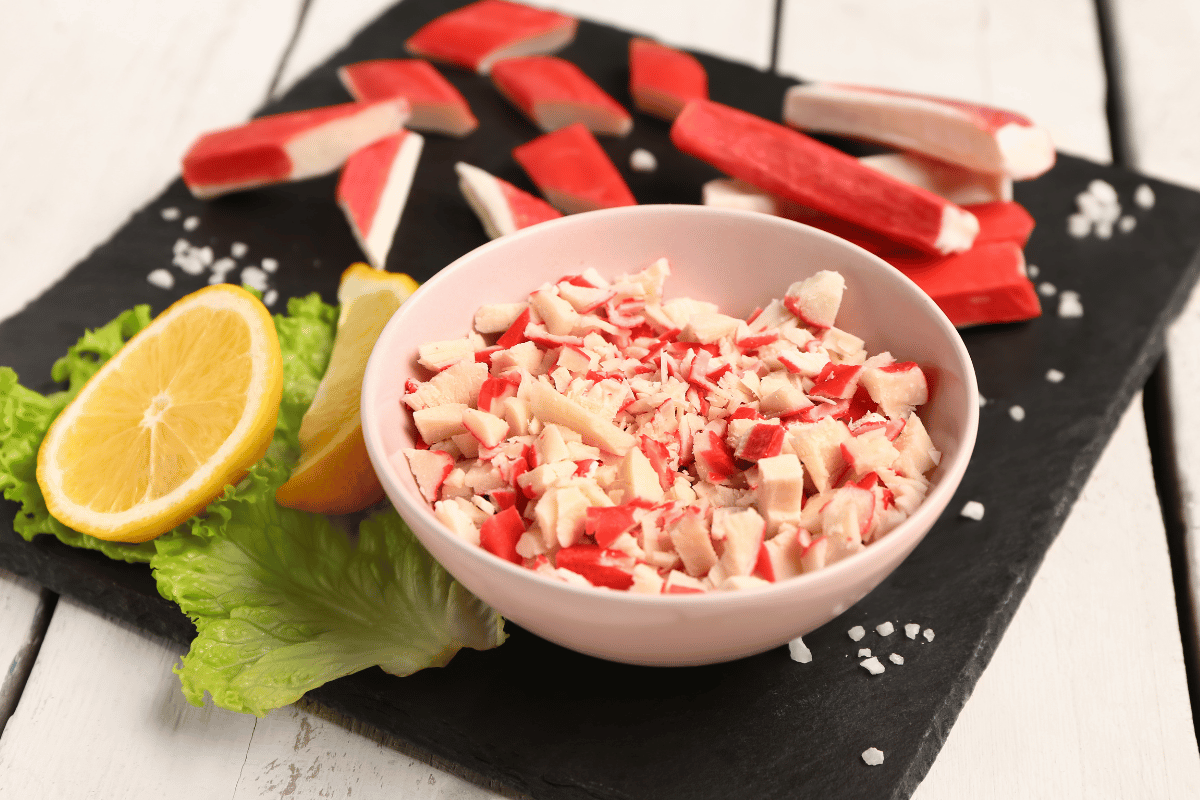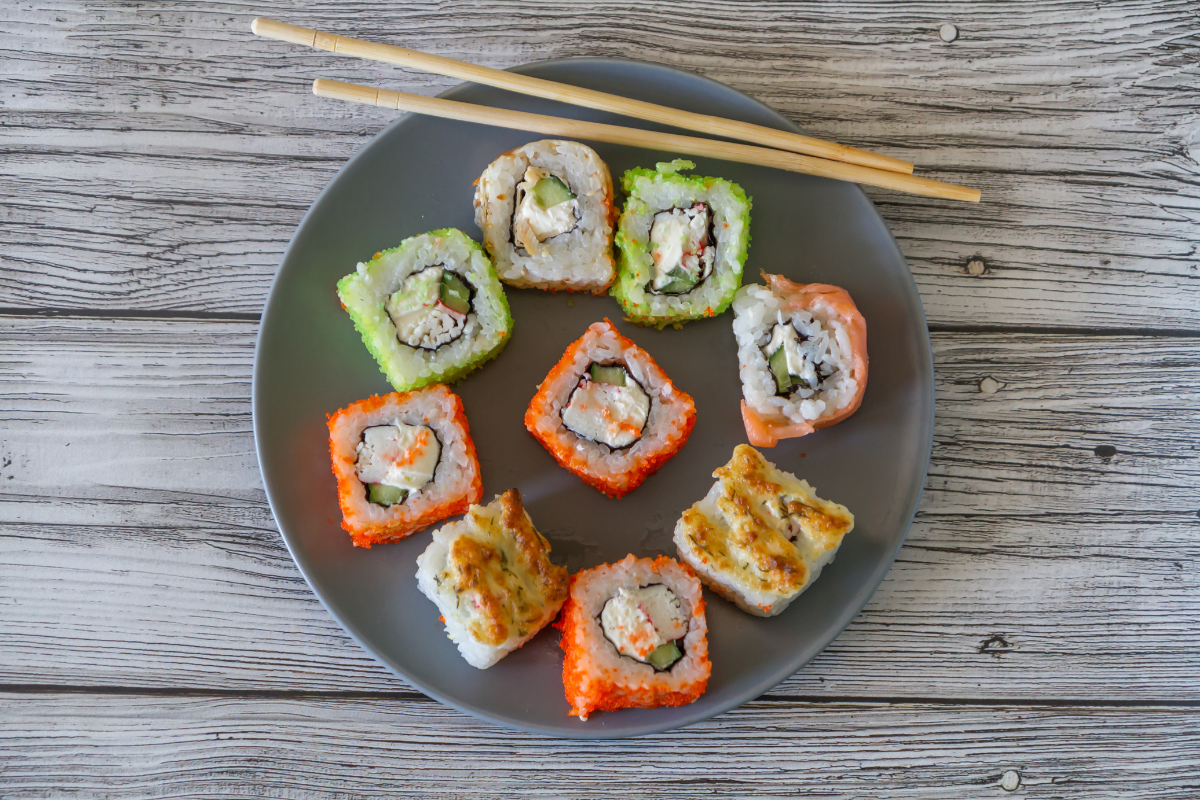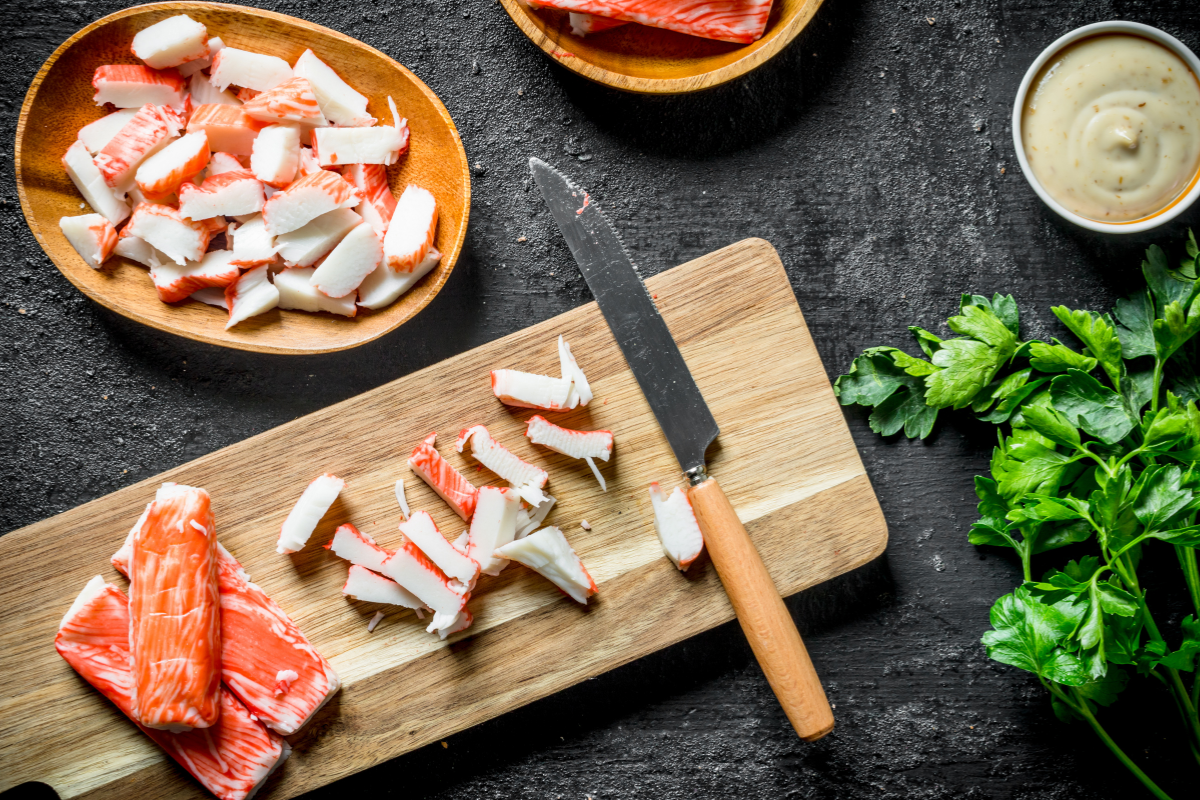Imitation crab, a budget-friendly and versatile seafood alternative, has become a staple in kitchens worldwide. But this ingenious creation raises many questions: can you eat it raw, is it healthy, and how does it compare to real crab? Dive into this comprehensive guide to explore the fascinating world of imitation crab, from its surprising ingredients to its diverse culinary applications.
Understanding Imitation Crab
What is Imitation Crab?

Imitation crab, a staple in seafood aisles, is more than meets the eye. Crafted from surimi—a fish paste primarily made from pollock—this versatile ingredient undergoes a transformation, emerging as the crab-like product we know and love. But, here’s the kicker: despite its name, there’s not a pinch of crab in it! This revelation often leaves folks scratching their heads, pondering, “What exactly am I eating?” Well, let me tell you, it’s a concoction of fish, starch, and a dash of magic (read: culinary science) that mimics the texture and flavor of real crab.
The Rise of Imitation Crab in Cuisine
Now, you might be wondering, “How did this imposter crab wiggle its way into our hearts and plates?” It’s simple, really. Affordability and convenience played a huge part. With the price of real crab meat soaring, imitation crab became the go-to for seafood lovers on a budget. Plus, its pre-cooked nature means it’s a time-saver in the kitchen. Whether tossed in a salad, stirred into pasta, or rolled into sushi, imitation crab has proven its worth. But, as it sauntered into the limelight, questions about its nutritional value and safety began to bubble up. Can you really eat it raw? Well, folks, that’s a tale for another section.
In a nutshell, imitation crab is a fascinating food product that has found its way into various cuisines around the globe. Its creation, rooted in practicality and innovation, showcases the lengths we go to enjoy the essence of seafood, without the hefty price tag. As we peel back the layers of this seafood substitute, we uncover a story of adaptability and culinary creativity. Stay tuned as we delve deeper into the world of imitation crab, exploring its nutritional landscape and debunking myths along the way.
Safety and Consumption
Can Imitation Crab Be Eaten Raw?
The culinary world is brimming with questions, but one that frequently bubbles to the surface is whether imitation crab can be savored without the touch of heat. This curiosity stems from its ubiquitous presence in dishes where it often appears uncooked. The straightforward scoop? Absolutely, imitation crab can be eaten right out of the package. But, let’s peel back the layers to understand the hows and whys, ensuring you’re fully clued in.
The Process of Making Imitation Crab
The journey of imitation crab from fish to your fork is a fascinating tale of transformation. At its heart lies surimi, a fish paste primarily crafted from pollock, which is then flavored and colored to mimic the beloved crab meat’s taste and texture. However, the pivotal moment in this process is cooking. Yes, before imitation crab even makes its way into your shopping cart, it has been thoroughly cooked. This crucial step ensures that the product is ready to eat, offering a convenient and quick option for those craving seafood without the prep time.
Safety Concerns and Recommendations
While it’s comforting to know that imitation crab is pre-cooked and ready to eat, there are still a few safety nets you’d want to keep in mind. For individuals with specific food allergies, such as to fish, wheat, or eggs, caution is the word. Imitation crab often contains these allergens, making it important to read labels closely. Storage is another key consideration; keep imitation crab refrigerated and pay heed to the expiration date to dodge any unwanted foodborne adversaries. And for those watching their sodium intake, moderation is advised, given the product’s typically high salt content.
In essence, imitation crab stands as a testament to culinary innovation, offering a blend of convenience and flavor. Whether enjoyed straight from the package or as part of a more elaborate dish, it remains a versatile player in the gastronomic game. Just remember, a little caution goes a long way in ensuring your dining experience is both safe and delightful.
Culinary Uses
How to Incorporate Imitation Crab in Your Diet
Imitation crab, with its versatile nature and mild flavor, has become a beloved ingredient in kitchens worldwide. Whether you’re a seasoned chef or a culinary novice, incorporating this seafood substitute into your diet can add a splash of creativity and convenience to your meals. Here’s the scoop on how to make the most out of imitation crab.

First off, sushi rolls and seafood salads are just the tip of the iceberg. Imitation crab shines in a myriad of dishes, from comforting soups and chowders to zesty pasta and vibrant stir-fries. Its pre-cooked nature means it can be added last-minute to hot dishes, ensuring it retains its delicate texture. For a refreshing take, mix it into cold salads or use it as a topping for crackers and canapés, blending seamlessly with various dressings and sauces.
Popular Recipes Featuring Imitation Crab
Diving deeper into the culinary sea, let’s explore some crowd-pleasers. California rolls and seafood salads are classic starters, but why stop there? Elevate your brunch game with an imitation crab omelet, or toss it into a creamy pasta for a quick weeknight dinner. For those who love a good crunch, imitation crab cakes are a must-try, offering a delightful twist on the traditional crab cake.
Tips for Cooking with Imitation Crab
While imitation crab is incredibly user-friendly, a few tips can enhance your cooking experience. Remember, it’s already cooked, so add it to your dishes towards the end of the cooking process to maintain its texture and flavor. When it comes to seasoning, imitation crab pairs well with a wide range of flavors, from bold spices to subtle herbs, making it a versatile player in your culinary lineup. Lastly, for the best texture, avoid overcooking, as it can become rubbery if exposed to high heat for too long.
For readers interested in exploring how to incorporate imitation crab into their meals, the article on “healthy and delicious imitation crab recipes” offers a wealth of ideas.
In essence, imitation crab is a culinary chameleon, adept at taking on the flavors and textures of your favorite dishes. Its ease of use, combined with nutritional benefits, makes it a smart choice for quick, healthy meals. Whether you’re whipping up a simple snack or a sophisticated entrée, imitation crab is ready to elevate your culinary creations with a touch of seafood flair.
Comparison with Real Crab
Imitation Crab vs. Real Crab Meat
When it comes to choosing between imitation crab and real crab meat, the decision boils down to more than just taste—it’s about experience, nutrition, and budget. On one hand, real crab meat boasts a delicate, sweet flavor and tender texture that seafood aficionados cherish.Packed with protein, omega-3 fatty acids, and essential vitamins and minerals, it offers a nutritious choice for anyone looking to enjoy the bounty of the sea.
On the flip side, imitation crab offers a more wallet-friendly alternative that still captures the essence of crab’s flavor and texture. While it may not match the nutritional profile of its real counterpart, it provides a convenient and versatile option for everyday cooking. Plus, its longer shelf life and ease of preparation make it a go-to ingredient for busy home cooks and professionals alike.
Taste and Texture Differences
Diving deeper into the sensory aspects, the taste and texture of imitation crab and real crab meat are distinct. Real crab meat is known for its rich, sweet flavor and flaky texture, a true treat for the palate. Imitation crab, while designed to mimic these qualities, has a milder taste and a slightly firmer texture. For some dishes, this difference can be a deal-breaker, while for others, it’s barely noticeable.
Price and Accessibility
One of the most compelling reasons to opt for imitation crab is its affordability. Real crab meat can be pricey, especially when out of season or sourced from premium varieties. Imitation crab, on the other hand, is consistently available at a fraction of the cost, making it an attractive option for those on a budget or feeding a crowd.
Moreover, imitation crab is readily available in most supermarkets, whereas real crab meat may require a trip to a specialty store or seafood market. This convenience factor, combined with its long shelf life, ensures that imitation crab is a staple in many pantries, ready to be transformed into a delicious meal at a moment’s notice.
In conclusion, while real crab meat holds a special place in the hearts of seafood lovers, imitation crab stands as a worthy alternative for those seeking convenience, affordability, and versatility in their culinary adventures. Whether you’re crafting a quick weeknight dinner or a festive seafood spread, understanding the differences between these two options can help you make the best choice for your needs and preferences.
Health Considerations
Is Imitation Crab Healthy?
Navigating the waters of nutritional value, imitation crab presents a curious case. On the surface, it appears as a low-fat, low-calorie option, making it an attractive choice for those on a health-conscious journey. However, diving deeper reveals a more nuanced picture. While it does offer certain benefits, such as being a source of protein and some minerals, there are aspects that warrant a closer look.
For starters, imitation crab is often high in sodium and contains additives and preservatives to extend its shelf life and enhance its flavor. These components can be a concern for individuals with high blood pressure or those trying to minimize their intake of processed foods. Additionally, the presence of wheat and other fillers to achieve its texture raises gluten concerns for those with sensitivities or celiac disease.
Allergies and Dietary Restrictions
When it comes to allergies and dietary restrictions, imitation crab requires careful consideration. If you have fish allergies, you should avoid imitation crab since its main ingredient, surimi, is made from fish. Furthermore, the inclusion of wheat and sometimes egg whites to bind the mixture together means that individuals with gluten or egg allergies need to steer clear or seek out specific brands that cater to their dietary needs.
When to Avoid Imitation Crab
Beyond allergies and sensitivities, there are other scenarios where imitation crab might not be the best choice. If you’re watching your processed food intake, the additives and preservatives found in imitation crab may be a concern. Those who focus on nutrition or whole foods may also notice lower levels of omega-3 compared to real crab, which may lead to reduced consumption.
Ultimately, imitation crab offers convenience and flavor for various dishes, but it’s crucial to balance its benefits with your health objectives and dietary needs. It can fit into a balanced diet when eaten in moderation and with awareness of its nutritional value and ingredients. Understanding these health considerations ensures that you can enjoy imitation crab in a way that aligns with your wellness journey.

FAQs
Frequently Asked Questions
Can imitation crab be eaten straight from the package?
Absolutely! Since manufacturers pre-cook imitation crab during its production, you can safely eat it straight from the package. This makes it a convenient snack or a quick addition to salads and other dishes.
How does imitation crab compare to real crab in terms of nutrition?
While imitation crab offers some nutritional benefits, such as being low in calories and fat, it doesn’t quite stack up to real crab when it comes to protein and omega-3 fatty acid content. Additionally, imitation crab tends to be higher in sodium and contains additives and preservatives.
Does eating imitation crab pose any health risks?
For most people, eating imitation crab in moderation poses no significant health risks. However, individuals with specific dietary restrictions or allergies—particularly to fish, wheat, or eggs—should be cautious. The high sodium content may also be a concern for those with hypertension or heart disease.
what is the best way to eat imitation crab meat?
can i freeze imitation crab meat
can you cook imitation crab?
How can I tell if imitation crab is bad?
Imitation crab should smell fresh and have a moist, firm texture. If it has a sour or fishy smell, looks slimy, or changes color, it’s safest to throw it away.
Always check the expiration date on the package before consuming.
We’ve explored imitation crab’s versatility, nutrition, and comparison to real crab. It’s a cost-effective choice for various dishes. Knowing its health effects and dietary fit is essential. Using imitation crab wisely, for convenience, flavor, or affordability, is crucial. This ensures it contributes positively to a balanced diet.

